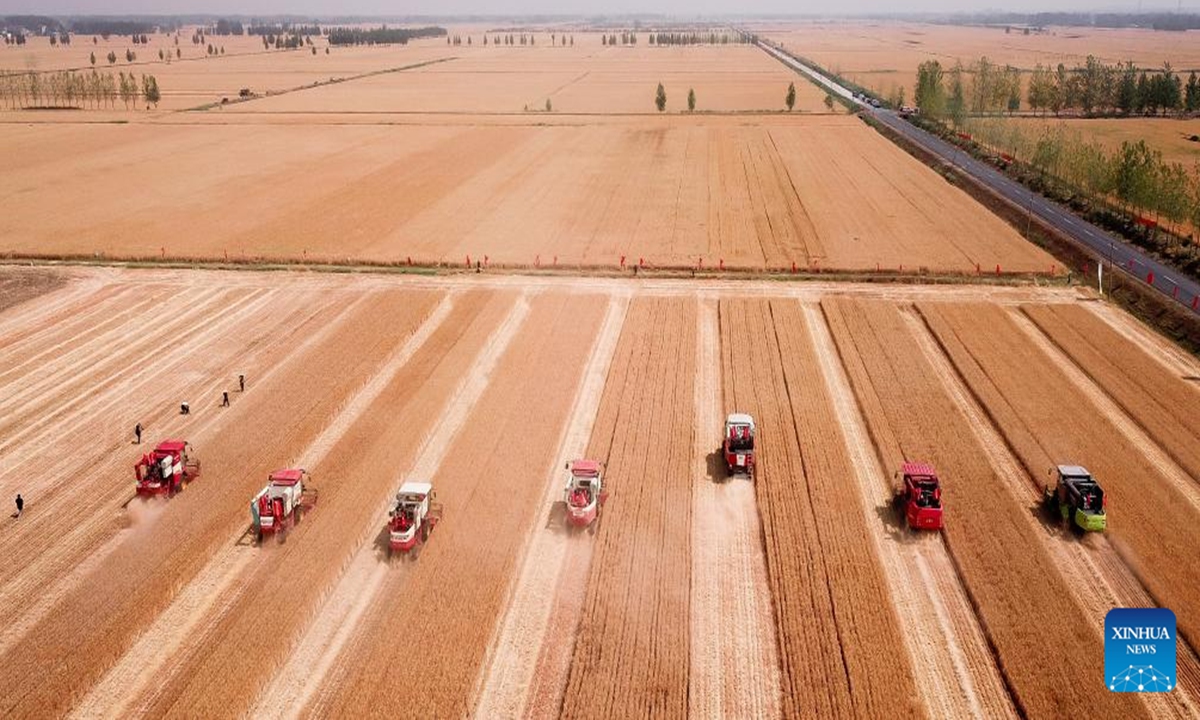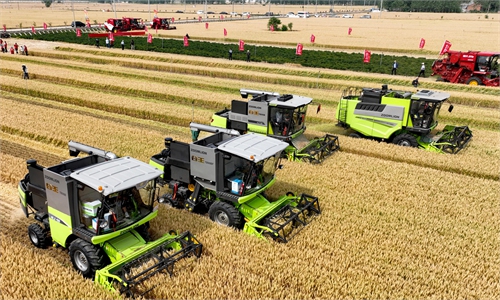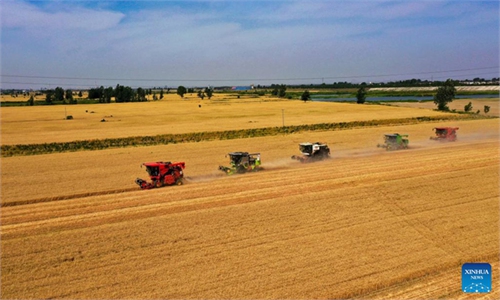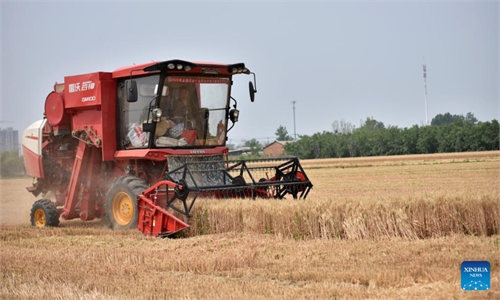China harvests around 78.5% of winter wheat with bumper output
Smooth production ensures food security amid global risks

Aerial photo taken on June 2, 2022 shows harvesters reaping wheat in the field in Tancheng County of Linyi City, east China's Shandong Province. Shandong, one of the country's major wheat production base, has ushered in its harvest season in this summer at present. (Xinhua/Guo Xulei)
China's summer harvest is being carried out at full swing, with a bumper harvest expected thanks to a variety of policies and incentives such as one-off subsidies and a higher grain purchase price, helping guarantee the country's food security amid volatile global food market.
As of Sunday, the country had finished reaping winter wheat on 239 million mu (15.93 million hectares) of farmland, accounting for around 78.5 percent of its total winter wheat, 1.2 percentage points faster than the previous year, according to the Ministry of Agriculture and Rural Affairs.
Wheat harvesting in Central China's Henan Province and East China's Jiangsu Province has almost come to a close, while harvesting in Northwest China's Shaanxi, East China's Shandong and North China's Shanxi provinces is in full swing.
The epidemic did not slow the overall harvesting process, and areas that have completed harvesting so far have seen rosy outputs, with most seeing the highest yields in recent years, Jiao Shanwei, editor-in-chief of industry news website cngrain.com, told the Global Times on Sunday.
The quality of the summer wheat is above expectations as well, including crops from Anhui, Hubei and Henan provinces, Jiao said, stressing that the hard-won summer grain production has laid the foundation for a good harvest for the year.
China's summer harvesting mainly focuses on winter wheat and oilseed rape. Generally spanning from May to late June, grain production in the period accounts for about one-quarter of the annual total, and therefore it is of great significance to the country's food security.
At a recent meeting, Chinese Premier Li Keqiang reiterated that the summer harvest is important to attaining the country's annual grain output goal. He called for smooth logistics for agricultural equipment and personnel, and urged governments at all levels to "waste no time and leave no single grain unharvested" during the harvesting season.
This year, the country has pledged to keep grain output above 650 billion kilograms. To achieve this, China has rolled out a variety of policies and incentives, such as increasing the amount of one-off subsidies and expanding the coverage of plantation insurance, said Li Guoxiang, a research fellow at the Rural Development Institute under the Chinese Academy of Social Sciences.
On Friday, the Ministry of Finance (MOF) and the Ministry of Agriculture and Rural Affairs announced 34 measures to support farmers and farming in 2022, including one-off subsidies, the establishment of high-standard farming land and the protection of seeds.
In addition to 20 billion yuan ($2.98 billion) worth of one-off subsidies distributed in March, the country pledged another 10 billion yuan from the central government budget to grain farmers in May to ease the impact of rising prices of farming supplies and spark farmers' motivation, according to the MOF.
The authorities also raised the national minimum purchase price of wheat to 115 yuan per 50 kilograms, up 2 yuan year-on-year, according to data from the National Food and Strategic Reserves Administration.
The state-owned grain enterprise Sinograin is preparing to purchase harvested new grain, making ready warehouses with a capacity for more than 40 million tons of grain. The company had purchased 110,000 tons of wheat by Friday, with average prices of 3,000-3,100 yuan per ton (150-155 yuan per 50 kilograms), playing an active role in safeguarding the interests of farmers while boosting market purchases.

Graphic: GT
With strong support from governments and farmers' soaring enthusiasm due to increasing grain prices, a good harvest is expected this year, Li said. The difficulties caused by the epidemic, such as delivery of agricultural materials, have been solved and did not have much effect to the overall summer grain production.
The bumper harvest comes amid soaring international wheat prices, as the Russia-Ukraine conflict has severely affected grain trade. According to a new report released by the UN Food and Agriculture Organization, the global wheat price rose 56.2 percent year-on-year in May, and it was only 11 percent below the record high reached in March 2008.
Against the backdrop of skyrocketing inflation and the turbulent geopolitical situation, grain prices will remain high in the international market, experts said.
"But it won't have much of an impact on domestic grain supplies, given relatively sufficient stockpiles and a good performance in terms of domestic production," Jiao said.
In the second half of the year, plans for extreme weather and pests need to be prepared in advance to ensure year-round food production, he said.



